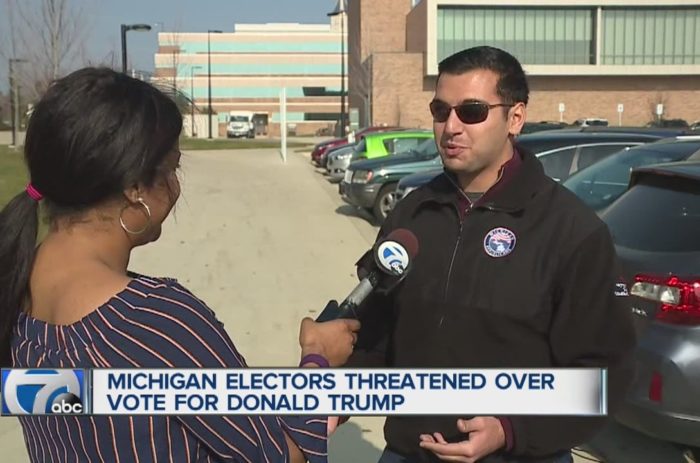
Centrist republican governor Brian Sandoval welcomes President Obama to Nevada in 2011.
The following is an excerpt from OpinionJournal’s “Best of the Web” at The Wall Street Journal written by the editor, James Taranto.
Duck Soup
It appears the president and his advisers realize there’s no easy way to break the political stalemate over filling the vacancy caused by Justice Antonin Scalia’s death. The Washington Post reported yesterday they’ve put out word they’re considering an improbable move:
The White House is considering picking the Republican governor from Nevada to fill the current vacancy on the Supreme Court, scrambling political calculations in what is expected to be a contentious confirmation battle in which Senate Republicans have pledged to play the role of roadblock.
President Obama is weighing the selection of Brian Sandoval, a centrist former federal judge who has served as governor since 2011, according to two people familiar with the process. Though the review process is in its initial phases and it is unclear whether the governor could ultimately emerge as the president’s pick, even the prospect of his nomination poses a difficult dilemma for Senate Republicans who have promised not to consider any nomination before November’s elections.
“Centrist,” we should note, is a political designation; no one knows much about Sandoval’s legal philosophy (before entering electoral politics, he was a trial judge—a practical position more than a philosophical one). In any case, it’s far from clear that the Sandoval gambit would succeed, and it would not be without risk for the Democrats.
For one thing, a Republican governor, even a centrist one, would not be the ideal nominee from the standpoint of the Democratic electoral base, who might see the pick as a surrender. Sen. Harry Reid, the Democratic leader, told CNN he’d back his fellow Nevadan, but it’s not clear he’d find many followers.
As we noted last week, Nevada’s other senator, Republican Dean Heller, alluded to Sandoval as a hypothetical nominee he could get behind. Two liberal Republican senators, Susan Collins of Maine and Mark Kirk of Illinois, have broken from their leadership and said the Judiciary Committee should at least hold hearings.
But neither Collins nor Kirk—nor Heller—sits on the committee, whose Republican members, as National Review noted Tuesday, “told reporters that they were united behind Majority Leader Mitch McConnell’s call to block any action toward confirming the president’s nominee.” Even if a nomination were to make it out of committee, at least four Republicans would have to vote for confirmation, and it would take 14 GOP defectors to break a filibuster.
Besides, would Sandoval accept the nomination if it were offered? We can think of two reasons why he might not. The first is party loyalty: Centrist though he may be, he would surely come under pressure not to cooperate with a Democratic president’s effort to frustrate the Republican strategy on a matter as important as the court’s future.
The second applies to all prospective nominees: Why should he go through the hassle—submission of paperwork to the White House, FBI background check, the possibility of brutal hearings—for a nomination that is likelier than not to be unsuccessful? In Sandoval’s case there would be an additional consideration: He could be a plausible compromise nominee next year in the event that the Senate and White House are controlled by different parties. Why poison that well by accepting the nomination now, in far less favorable circumstances?
Given the decades-long history of Senate Democrats’ blocking Republican presidents’ judicial nominees, it’s understandable that the Republican majority would take a hard line now that the tables are turned—and that Republican voters would expect no less.
Earlier this week, thanks to C-Span, it emerged that on June 25, 1992, Joe Biden, then chairman of the Judiciary Committee, had made a long statement on the Senate floor insisting that President Bush “not name a nominee until after the November election.” The arguments he made were much the same as those Republicans are offering now.
There was no vacancy at the time, but there were rumors that Justice Harry Blackmun, author of Roe v. Wade, might retire at the end of the 1991-92 term. In the event, he remained on the court for two more years. Four days after the Biden speech, the court upheld Roe’s “core holding” by a 5-4 vote in Planned Parenthood v. Casey . In a separate opinion “concurring in part, concurring in the judgment in part, and dissenting in part,” Justice Blackmun engaged in a bit of electioneering on behalf of Democratic nominee Bill Clinton:
I am 83 years old. I cannot remain on this Court forever, and when I do step down, the confirmation process for my successor well may focus on the issue before us today. That, I regret, may be exactly where the choice between the two worlds will be made.
In his own separate opinion, “concurring in the judgment in part and dissenting in part,” Justice Scalia observed:
Value judgments . . . should be voted on, not dictated; and if our Constitution has somehow accidentally committed them to the Supreme Court, at least we can have a sort of plebiscite each time a new nominee to that body is put forward. Justice Blackmun not only regards this prospect with equanimity, he solicits it.
And here we are today. No wonder Sen. Chuck Schumer—who in 2007 argued against confirming any high-court nominee from the second President Bush—now says: “It doesn’t matter what anybody said in the past.”
The New York Times is following that advice, in a hilarious editorial today titled “Senate Republicans Lose Their Minds on a Supreme Court Seat.” It begins: “Following the death of Justice Antonin Scalia, Senate Republicans apparently believe they can profit by creating a political crisis that the nation has never seen before.”
A vacancy on the Supreme Court is “a political crisis that the nation has never seen before”? Our first thought was that these people must be too young to remember, say, the Civil War. But actually, when you read that sentence carefully, it is meant to sound alarming but is actually trivial. Whether or not this is a “crisis,” it is true that “the nation has never seen [it] before” in the same sense it is true that every snowflake is unique.
The Times quotes Sen. John Cornyn of Texas, the Republican whip and a Judiciary Committee member, as saying: “We believe the American people need to decide who is going to make this appointment rather than a lame-duck president.” It calls this assertion “so twisted that it’s hard to know where to begin,” then begins:
First, Mr. Obama is not a “lame-duck president.” The lame-duck period is broadly understood to run from after the November election until a new president is inaugurated in January. November is more than eight months off. Based on the average number of days it has taken the Senate to act on previous Supreme Court nominees, the seat could be filled by this spring.
Second, no matter how often Republicans repeat the phrase “let the people decide,” that’s not how the system works. The Constitution vests the power to make nominations to the court in the president, not “the people.” In any case, the people have already decided who should make this appointment: They elected Mr. Obama twice, by large margins.
The Times elides the distinction between nomination, a presidential power, and appointment, which requires the Senate’s consent. As to the paper’s definition of “lame duck,” it finds some support from Merriam-Webster, whose second definition is “an elected official or group continuing to hold political office during the period between the election and the inauguration of a successor.” But the third definition is less specific: “one whose position or term of office will soon end.”
The Times itself has been less than strict in its adherence to what it now claims is the “broadly understood” definition. It called George W. Bush a lame duck at least three times when he had more time in his second term than Obama does now. Dec. 6, 2007: “President Bush’s lame-duck attempt to repair the Republican Party’s threadbare fiscal reputation is an increasingly reckless game.” Feb. 4, 2008: “Even allowing for the low expectations we bring to any lame-duck president’s final State of the Union address, President Bush’s brief discussion of climate change seemed especially disconnected from reality.” Feb. 5, 2008 (headline): “Lame-Duck Budget.”
Lest anyone accuse us of inconsistency, this column observed on Jan. 25, 2008: “George W. Bush is a lame duck; he leaves office 361 days from today.”
None of these examples have to do with the courts, but here’s an excerpt from a July 2, 1987, Times editorial about the nomination of Robert Bork:
Just as a President reflects his political values by whom he nominates, the Senate needs to reflect its political values by whom it approves. The Supreme Court may follow the election returns; the fate of Supreme Court nominations surely does. The relevant elections are not only those of 1980 and 1984, when the operative word was landslide. The 1986 election put Democrats in control of the Senate and made the operative word lame duck.
“Lame duck” is two words, but that is a quibble.
But hey—if the White House is putting out trial balloons about breaking the impasse by nominating a Republican politician, we can do it too. Why doesn’t Obama nominate Sen. Ted Cruz of Texas?
Cruz would be even harder than Sandoval for Republicans to oppose, and if he accepted the nomination, he could guarantee the immediate support of one GOP Judiciary Committee member, namely Sen. Ted Cruz of Texas.
True, he’s unpopular with his Senate colleagues. But that might be a plus, since sending him to First Street would get him out of the Capitol. That would put an end to his government shutdowns, which vex Obama and congressional Republicans alike.
And it would get him out of the race for president, putting Marco Rubio in a commanding position to stop Donald Trump at last. It’s such a win-win that everybody would be tired of winning. Well, everybody except Trump.
Alas, Obama probably won’t do it. This country doesn’t win anymore.
For more “Best of the Web” from The Wall Street Journal’s James Taranto click here.



